SAFETY AND SUPPORT FOR
PARENTS & CAREGIVERS
Protecting children from sexual abuse is an adult responsibility and requires bravery, knowledge, and skills. Our mission is to provide tools and support empowering you to keep children safe and prevent sexual abuse.
The Power of Prevention
Be Empowered. Be Engaged. Be the Change.
Sexual Assault Hotline. Free. Confidential. 24/7
(866) 811-7473
Our vision is a world free of sexual violence.
Protecting children from sexual abuse is an adult’s responsibility and requires bravery, knowledge, and skills. Our mission is to provide tools and support, empowering you to keep children safe and prevent sexual abuse from happening.
You will discover a compilation of strategies, tips, and tool kits, informed by best practices, designed to raise awareness, increase competency, and build confidence, so together, we can keep children safe. The information provided is not a substitute for the advice of professionals. These are not therapeutic tools or guaranteed methods.
As the field of primary prevention evolves, we will strive to update these pages with information and resources parents and caregivers want and need. We always welcome questions and feedback.
We recognize that some of you may be adult survivors of child sexual abuse and understand the content may trigger difficult memories or emotions. We believe you. It was not your fault. You are not alone.
We invite you to reach out for support.
Our Statewide Hotline is accessible 24 hours a day.
1-866-811-RISE (7473)
If you would like more information about the services, we offer please click here. SAC is here to help.
Be in the Know:
Learn the Facts About Child Sexual Abuse.
DEFINITIONS, GROOMING, PREVALENCE, RISK FACTORS, IMPACT - Click Here.Be Proactive
Reduce The Risk Of Child Sexual Abuse.
Steps Parents & Caregivers Can Take to Protect Children - Click Here.Be Brave
Talk With Children & Teens About Safety.
Talking points For Children, Body safety conversation Starters, Body Safety rules, Listening to Children, talking with teens, Activity Books - Click Here.Be-come Aware
Recognize The Warning Signs Of Child Sexual Abuse.
Children, Teens, Characteristics of Perpetrators - Click Here.Be Ready
Know What To Do When...
Receiving a Disclosure, Addressing Boundary Violations - Click Here.Be in the Know
Learn the Facts About Child Sexual Abuse.
Print or Download Our Be in the Know About Child Sexual Abuse PDF
What is child sexual abuse?
Child Sexual Abuse is a significant but preventable adverse childhood experience and public health problem.
Child Sexual Abuse IS NEVER THE CHILD's FAULT.
Child Sexual Abuse is a CRIME, punishable by law and MUST BE REPORTED.
Child Sexual Abuse includes any sexual contact between an adult and a child or teen. It can also include sexual contact between children when one child is more powerful than the other because of age, size, or ability. Sexual contact includes touching and non-touching behaviors. Both are traumatizing to children and teens.
- Touching behaviors may or may not involve force or pain:
- Fondling or rubbing against genitals, buttocks, or breasts.
- Penetration of the mouth, anus, or vagina by the abuser or with an object.
- Non-touching behaviors include exposure of children to sexually explicit acts, images, or communication.
- Exhibitionism-exposure of the abuser's genitals to children.
- Voyeurism-watching others when they are naked/exposed or engaged in sexual activity.
- Taking sexually explicit or provocative photos or video of children’s bodies.
- Showing pornography or sexually suggestive images.
What is grooming?
“Grooming is a gradual, calculated process by which the offender draws a victim into a relationship and maintains that relationship in secrecy. “ - Dr. Michael Weiner, Associate Professor of Psychiatry at NYU
6 Stages of Grooming
- Offenders target victims they perceive as vulnerable.
- Offenders gain trust by watching and gathering information about children and their needs.
- As needs are met, trust deepens. The child may begin to idealize the offender.
- Offenders begin isolating children, creating situations where they are alone: car rides, special outings, extra practice; serving to deepen the child’s emotional dependence on the relationship. Adults may reinforce the relationship as they appreciate the special interest the offender has taken in the child and feel indebted as the offender fills unmet needs in the family. They may increase the offender’s access to the child.
- Offenders begin to sexualize the relationship, exploiting the child’s curiosity and biological responses.
- Offenders maintain control using fear and manipulation.
If you know or suspect child abuse or neglect, you are legally required to make a report.
Click here or Call the Tennessee Child Abuse Hotline: 1-877-237-0004. This 24-hour reporting line is operated by the Department of Children’s Services (DCS).
All you need is a CONCERN.
You do not need to have evidence, or be certain something happened.
As a reporter, you have the right to remain confidential and anonymous.
Call Now. Failure to report abuse is a violation of the law.
What are the different types of abuse?
- Sexual Assault describes any type of unwanted sexual encounter where one person does not consent or have the capacity to consent. Those who are under the legal age of consent, under the influence of a substance, or experiencing some kind of impairment cannot consent. This term includes rape and child sexual abuse.
- Child Sexual Abuse is a term used to describe any type of sexual contact when the victim is less than 13 years old. This includes touching behaviors like rape, molestation and fondling, or any non-touching behaviors for the sexual gratification of another person.
- Rape is forced penetration. Forced penetration includes vaginal, anal, or oral penetration by the offender(s). Rape can happen when any body parts or other foreign objects are inserted into any part of a person’s body.
- Incest is sexual contact involving penetration between family members. The abuser can be a parent, a child, a grandparent, uncle, aunt, nephew, niece, stepparent, stepchild, stepsibling or half-sibling. The relationship can be biological or adoptive.
- Statutory Rape is sexual contact involving penetration when the victim is at least 13 years of age but less than 18, and the abuser is at least 4 or more years older than the victim.
- Mitigated Statutory Rape is sexual contact involving penetration when the victim is at least 15 years of age but not older than 17 and the abuser is at least 10 years older than the victim.
- Sexual Battery is unlawful sexual contact that involves force or coercion and accomplished without consent of the victim.
Click here for more information about Tennessee Codes
How prevalent is child sexual abuse?
One in Ten Children Will Be Sexually Abused Before Their 18th Birthday. - D2L.org
Who sexually abuses children?
Children are most likely to be abused by someone they know. - RAINN.org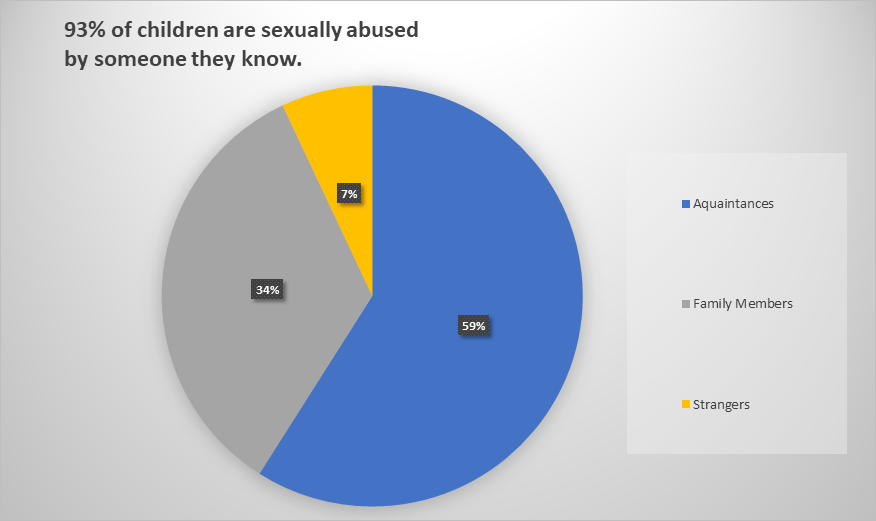
What factors make a child more vulnerable to child sexual abuse?
Children are more likely to become victims of sexual assault than adults.
This is the only crime where children outnumber their adult counterparts. - UNH.edu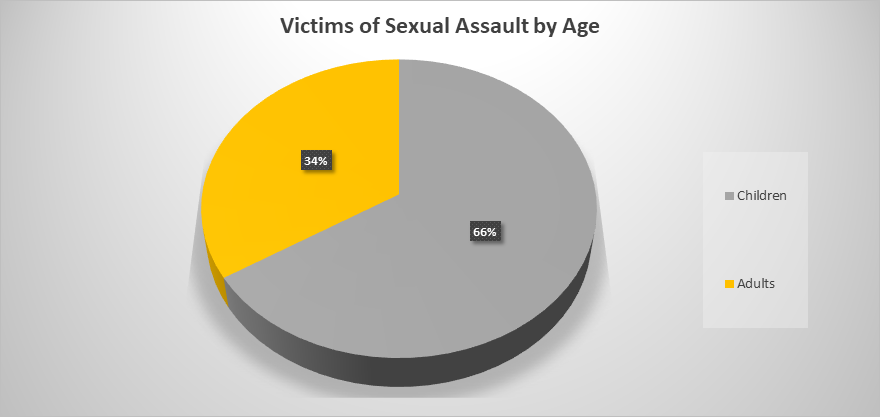
Children ages 12-17 are more likely to become victims of child sexual abuse. - RAINN.org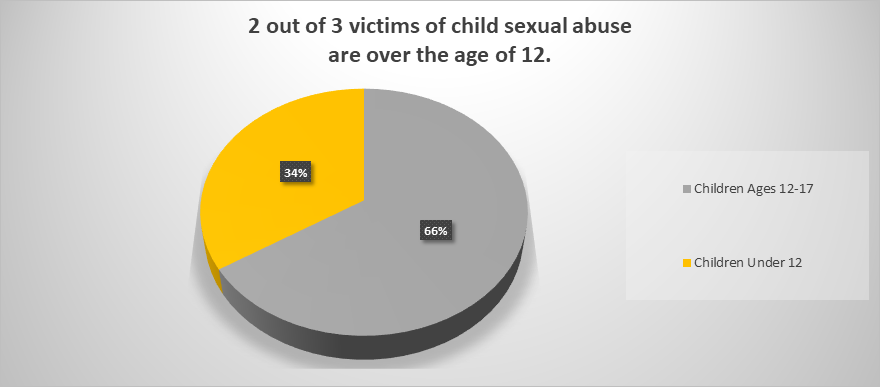
Girls are more likely to become victims of child sexual abuse than boys. - UNH.edu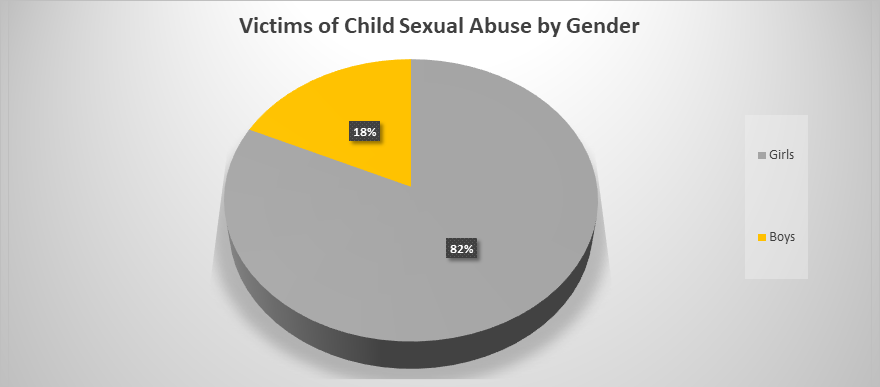
Only 12% of child sexual abuse is ever reported to the authorities. - NSVRC.org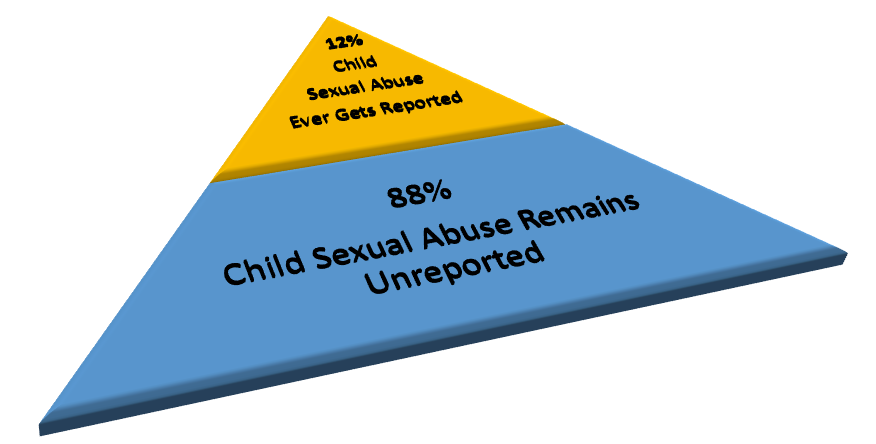
What is the impact of child sexual abuse?
Child sexual abuse is an adverse childhood experience (ACE) that has the potential to negatively impact how a person thinks, acts, and feels over a lifetime. Childhood trauma is a risk factor for nearly all mental health disorders. It is associated with the adoption of high risk behaviors that include substance abuse, running away, high-risk sexual behaviors, and others. The ACE study concluded that childhood trauma is linked to chronic diseases including cancer, diabetes, and heart disease.
Children who have been sexually abused are more likely to experience the following during childhood and throughout their lives:
Depression
Substance Abuse
Eating Disorders
Difficulty with Attention and Focus
Aggression, oppositional or defiant behaviors
Self-inflicted injuries
Underperformance at school, dropping out
Running Away
Re-victimization Click here to read more
High Risk Sexual Behavior
HIV and Sexually Transmitted Disease
Teen Pregnancy
Sex Trafficking
High Utilization of Healthcare
Obesity
Chronic Disease: Diabetes, Cancer, Heart Disease
Suicide Attempts
Premature Death
Be Proactive
Reduce the Risk of Child Sexual Abuse.
Print or Download Our Be Proactive. Reduce the Risk PDF
Click here for additional info or to schedule training
What steps can adults take to protect children?
- Choose group situations where multiple adults supervise.
- Look for hidden or secluded areas in the physical environment and address these risks.
- Limit access-post signage, lock doors and secure keys
- Increase monitoring-perform regular checks, install monitoring system
- Install doors with windows
- Ensure interactions can be observed and interrupted.
- Inform other adults of any meeting or private conversation you need to have with a child.
- Sit in plain view of other adults
- Keep doors open when meeting with a child
- Ensure transparency when communicating with children and youth via email, text, and on social media.
- Copy parents/caregivers on emails and texts.
- Make social media posts public.
- Screening and evaluation of potential staff (includes volunteers and interns).
- Do interviews focus on the candidate’s ability to respect children, maintain boundaries, and intervene when they witness boundary violations?
- Do organizations check references, sex offender registry, and complete background checks?
- Do screening and evaluation practices apply to all staff regardless of their role or only to direct-service staff?
- Structured and documented onboarding and training of new staff
- Procedures defining appropriate, inappropriate, and prohibited conduct.
- Do parents, caregivers, and others have access to written copies of the policies and procedures?
- Are they provided opportunities to ask questions about these?
- Is there signage about safety rules?
- Does signage include information about mandatory reporting of known or suspected child abuse or neglect?
- Is there a clear response plan to address child disclosures of abuse and boundary violations.
- Gains trust by filling roles, addressing unmet needs of the child and family.
- Spends time with children outside their role with the child-organizing fun activities, attending events, transporting.
- Offers favors and gifts that seem excessive or without occasion.
- Treats children/youth as friends or peers.
- Finds increased opportunities to spend time alone with children and teens like car rides and special outings.
- Talk to your child about internet safety. Encourage them to bring concerns to you. Check-in regularly.
- Set expectations for use. Engage children in the process. Hold them accountable when rules are broken.
- Remind children that it is your responsibility to keep them safe so you will be watching them.
- Let them know the device(s) belong to you.
- Know their passwords.
- Activate safety settings and parental controls.
- Use online software to control internet content.
- Ask children to teach you how to use their devices, navigate the latest apps, play their favorite on-line games.
- Be curious about your child’s interests.
- Follow them on social media. Follow their friends as well.
- Learn about their on-line gaming preferences and favorite websites.
- Encourage them to talk with you about anything that happens on-line.
- Intermittently ask children to show you their activity.
- Remain calm if you discover concerning activity. It’s an opportunity for a conversation.
- Learn more about online safety at www.NetSmartz.org
Click here for additional resources on Internet Safety
- Share what you have learned with other adults. Talk openly about the steps you are taking to protect children. Your story may empower another parent or caregiver.
- Allow children to be present when talking to others about your family’s safety rules and the expectations you have of other adults. It reinforces the importance of the safety rules you have put in place and keeps everyone accountable.
- Set expectations for adult supervision.
- Set limits about gifts
- Set boundaries around touching and affection.
- Let others know your child has learned body safety and assertiveness skills.
- Address boundary violations immediately: Describe the Behavior. Set a Limit. Move on.
Example
Describe the Behavior. Set a Limit. Move on.
Describe the Behavior: “It looks like you're forcing Justice to hug you. Justice looks uncomfortable."
Set a Limit: "Please stop. We let Justice decide who to hug."
Move On: "Justice let’s head to the kitchen and grab something to drink.”
Imagine a situation that you would recognize as a boundary violation or a vulnerable situation for a child.
Using the simple process above, what would you say and do if it happened today?
Describe the behavior:
Set a limit:
Move on:
Be Brave
Talk With Children & Teens About Safety.
Talking with children about preventing sexual abuse can be a part of the safety conversations you are already having, like preventing the spread of illness by handwashing and social distancing, wearing seatbelts, and what to do in case of a storm or fire.
Print or Download Our Talking Points for Parents and Caregivers PDF
Talking Points for Parents and Caregivers
Include TOUCHING safety rules when you talk about other types of safety. Tell children their bodies are special and belong to them. Explain there are safety rules for all their body parts. Help them understand the difference between touches that are okay to give and get and touches that are not. Tell them that no one should touch their private body parts except to keep them clean and healthy. They also need to know that an adult or bigger kid should never ask a child to touch an adult or bigger kid’s private body parts.
Include LOOKING safety rules. Children need to learn that it is never okay for an adult or older kid to look at or take pictures of children’s private body parts. Children also need to know that it isn’t okay for adults or older children to show their private body parts or someone else’s private body parts to a child.
Teach children the proper names for All their body parts. Children need to learn the anatomically correct names for their genitals. Penises and vaginas are body parts just like eyes, ears, and noses. This knowledge will help them develop a healthy understanding of their bodies, and will assist them in talking about any inappropriate or questionable behaviors, or touches.
Help children develop assertiveness skills. Teach children to stand up for themselves in a way that doesn’t hurt someone else. Have children stand tall, look a mirror, and practice saying,"No! I don't like that!" and "Stop it!! I'm telling!" Explain to children that sometimes adults can be wrong. Tell them it is okay to tell an adult, NO or STOP, especially if an adult is touching them in a way that makes them feel uncomfortable. Children need to understand that no means no all the time and touching safety rules apply to EVERYONE. It’s even okay for them to say no to you and you will respect the boundary.
Set up family rules regarding secrets. Teach children that secrets can be harmful especially secrets about touching. “Forever Secrets” make people feel confused, sad, or afraid. Forever Secrets may start with, “Promise you will never tell …” Explain that “Forever Secrets” are very different from “Happy Surprises.” “Happy Surprises” create excitement and make people smile. Happy Surprises might start with, “I can’t wait until they find out about…” It is never okay for an adult or older child to ask children to keep forever secrets, especially secrets about touching. Direct children to tell a safe adult if anyone asks them to keep a touching secret. Assure children you will believe them and they will not get in trouble for telling even if they promised someone else not to tell. Remind children to keep telling until someone listens.
Help children identify safe adults in their lives. Teach children that safe adult is someone the child feels comfortable with and can contact easily. Help children identify qualities that safe people have like taking good care of children, being respectful, and trustworthy. Children should be able to identify several safe adults, at home, school, and in their communities. Make lists to post at home and to carry. Let the safe adults know so they will be ready in case the child reaches out.
Teach children what to do if they can’t reach a safe adult they know. Help them identify other safe adults like those who respond to calls and chats through a child abuse hotline or other help lines where safe adults are always waiting to respond to their concerns.
Children’s coloring and activities books that can be downloaded and printed:
Be Brave Talk About It- Toolkit for Talking with Children About Body Safety
Print or Download Our Body Safety Toolkit PDF
Body Safety Toolkit
Talking with Children About Body Safety
Tips for Having the Talks
When it comes to learning about body safety, it is important to have frequent conversations, especially with younger children. Find quiet times and spaces to talk when you are relatively free from distraction. It’s helpful to plan talks particularly before children leave the house to visit someone new or spend the night away from home.
Before You Start
Breathe. You can do this! The more comfortable you are, the more comfortable they will be with their bodies and talking about body safety.
Conversation Starters
- “Your body is very special.”
- “I would like to talk with you about safety and how we can keep your body safe.”
- “We have safety rules for all parts of our body.”
- “You are in charge of your body.”
Bodies are Special- Teaching children to name their body parts is part of early childhood development. Every part has a name. Teaching children the anatomically correct names for their genitals is no different from teaching them to name their nose or an ear. It’s important for children to know that vaginas and penises are body parts like all the others. While they may be private body parts, they are not so private that they cannot be talked about. Having the correct words to describe their body parts makes it easier for them to ask questions and express concerns about their bodies.
You can start with: “Your body is very special and it belongs to you. Every part is special and has its own name. Some body parts are private. Private body parts are covered by a bathing suit. No one should touch your private body parts except to keep them clean and healthy.”
My Body is My Body- Children need to know that no one has the right to touch their bodies if they don’t want them to.
You can start with: “You are the boss of your body. If you do not want to be touched, you have the right to say NO. If they don't stop, when you say no, I want you to tell a safe adult.”
Privacy- Children and adults have the right to privacy.
You can start with: “All people have the right to keep their bodies from being seen by others when they go to the bathroom, take a shower, or change clothes. You can ask for privacy.”
Stop Means Stop- Children need to know their boundaries are respected. Provide them with opportunities to say no to touches from adults.
You can start with: “You can tell others to stop doing something you do not want them to do, like tickling or hugging. If you tell me to stop tickling you, I will stop....Lets’ practice!”
Surprises versus Secrets: Set expectations that you never keep secrets from each other. Help children understand the difference between surprises and secrets. You might want to tell them about “tricks” people use to keep children from telling secrets.
You can start with: “We never keep secrets from each other. We keep Happy Surprises. Happy Surprises create excitement and make people smile. Forever Secrets make people feel bad, confused, and afraid.”
You can continue with: “Some people use tricks to keep children from telling. They might say bad things like..., No one will believe you..., It's your fault..., You will get in trouble..., Someone will get hurt if you tell.”
Always end with: "If someone asks you to keep a secret, I want you to tell me or a safe adult. I will believe you. I can keep you safe.”
Tips by Age
Use anatomically correct names for genitals versus nicknames or slang.
Say, “Vaginas and penises are private body parts.”
“A bigger person should never touch your private body parts except to keep you clean and healthy.”
“We never keep secrets about touching.”
“If anyone touches your private body parts, it is okay to tell me. I want you to tell me.”
“If anyone tries to touch your private body parts, I want you to tell me or a safe adult. Keep telling until someone listens.”
“If someone asks you to keep a touching secret, I want you to tell me or a safe adult. It is okay to tell. I will believe you.”
“It is OK be curious about private body parts. Let’s talk about it together.”
“We respect all bodies. It is not OK to touch or take pictures of another person’s private body parts.”
“No one should ever take pictures of your private body parts or show you photos of another person’s private body parts.”
“If someone asks you to keep a touching secret, I want you to tell me or a safe adults. You won’t get in trouble.”
“It’s never ok to take or send photos of anyone’s private parts.”
“Your body belongs to you. No means no.”
For additional resources on teaching kids about body safety, safe adults, and assertiveness click here.
Click here for Our Family Body Safety Rules PDF
Family Body Safety Rules
I am the boss of my body!
It is okay to say NO if I don’t want to be touched.
We respect other people’s “NO.”
I have the right to privacy
We use proper names to talk about private body parts.
We never keep secrets about anything that feels bad, sad, or uncomfortable.
We keep a list of safe adults.
If I feel confused or uncomfortable about anything, I tell a trusted adult. I keep telling until someone listens.
Tips for Listening to Children
- Listen carefully when children ask questions or try to tell you something especially if it seems difficult for them to share.
- Children may ask questions about bodies or certain behaviors, including sex, rather than talk directly about something they experienced.
- Children may tell parts of what happened or pretend it happened to someone else to see how you react.
- Sometimes children lack the language skills to express themselves. Ask children if they would be willing to draw a picture or use toys to show you what they are trying to say.
- Reassure children that it is ok to tell you when someone makes them feel uncomfortable or confused, regardless of who it is.
- Remain calm. Children often shut down if you respond emotionally or negatively
How do I talk to teens about safety and sexual assault?
Be Direct - Share the facts about sexual assault. Bring up statistics that relate to them. Explain that no one “looks like a rapist,” and that eight out of 10 instances of sexual assault are committed by someone known to the victim. On in four girls and one in six boys will be exposed to sexual abuse before their 18th birthday. Two thirds of children who are sexually assaulted are between the ages of 11 and 17. Chances are they know at someone who has been sexually abused.
Talking With Teens About Safety and Sexual Assault
It is never too late to start having conversations with teens about safety and sexual assault. Talking with children now will pave the way for conversations as they mature and enter into their first dating relationships.
Be Curious- Ask what your teen thinks about sexual assault. Teens may have misconceptions about sexual violence that they have picked up from media and friends. Maybe they haven’t given it much thought at all, or perhaps, they think about it all the time following a friend’s disclosure.
Tips for Advancing Conversations with Teens
- Use open-ended questions that elicit more than yes/no answers to keep the conversation going.
- What do your friends say?
- What concerns you most?
- How do you make sense of it?
- What would it take to change your mind?
- Avoid “why” questions-“Why” can imply there is a right or wrong answer, triggering defensiveness, or shut down.
- Use reflections. Pay attention to body language, tone, and what is not being said. Reflect what you think your teen means. If you get it wrong, they will correct you. This creates space for additional conversation and deeper understanding.
- It doesn’t make sense to you. One minute they say yes and then it’s a no.
- You blame yourself for not saying something sooner.
- You have this question but you are hesitant to ask it. You worry what they will think.
- It’s not something you are concerned about. You can’t imagine yourself ever getting involved.
Be Relevant- Ask your teen’s opinion about something happening on social media or in the news. Watch a movie or show and ask their opinion about what they saw. Asking their opinion shows that you value their point of view and opens the door for more dialogue. Conversations that begin with “What if this happened to you or a friend” create opportunity for teachable moments and build trust.
Be Direct- Share the facts about sexual assault. Bring up statistics that relate to them. Explain that no one “looks like a rapist,” and that eight out of 10 instances of sexual assault are committed by someone known to the victim. On in four girls and one in six boys will be exposed to sexual abuse before their 18 th birthday. Two thirds of children who are sexually assaulted are between the ages of 11 and 17. Chances are they know at someone who has been sexually abused.
Be Transparent- Use your own experience to tell a safety story. Sharing your own experiences can make these conversations relevant and feel more real to teens. If you don’t have an experience you feel comfortable sharing, you can tell a story about someone you know. If a question comes up you do not know the answer to or need more time to think about say so. “I don’t know” is an okay answer.
Be-ing a Good Friend- Talk to teens about being a good friend. This achieves three things: 1) You convey, what matters to your teen, matters to you, their friendships. 2) You trust your teen’s capacity to do the right thing. 3) You get the chance to talk about safety practices your teen might not be receptive to otherwise.
Be Brave- Talk about consent, early and often.
What is Consent? 2 Minutes Will Change the Way You Think About Consent
Talking to Kids About Consent-Toolkit for Parents and Caregivers
Be-come Aware
Recognize the Warning Signs of Child Sexual Abuse
Although many children who have experienced sexual abuse show behavioral and emotional changes, many others do not. It is therefore critical to focus not only on detection, but on prevention and communication—by teaching children about body safety and healthy body boundaries, and by encouraging open communication about sexual matters.
What are the signs of sexual abuse in children?
Nightmares or problems sleeping Sleep and energy level
Shows resistance to routine bathing, toileting or removing clothes even in appropriate situations
Talks about their body being dirty or hurt, concern that something is wrong with their genitalia
Bloody, stained or torn underwear
Pain when toileting
Wetting or soiling pants, unrelated to toilet training
Sexually transmitted diseases, genital infections
Pregnancy
Isolating, socially withdrawn-may be avoiding traumatic reminders
Engaging in high-risk behaviors
- Indiscriminant sexual behavior
- Running away or disappearing for long periods of time
- Alcohol and drug use
- Increasingly secretive about internet or cell phone use
Anxiety, worry, irritability or anger
Thoughts of suicide, dying, wishing they’d never been born
Intentionally harming self-cutting, burning
Avoidance or fear of certain people or places
Unusual aggressive behavior or shows sudden mood swings including rage, fear or insecurity, depression or worry
Distracted or distant
Keeping secrets, particularly if it is one between the child and an older friend or adult
Talks about a new, older friend or suddenly has gifts, money or toys without reason
Displaying knowledge, behaviors or language of adult-like sexual nature
Playing, drawing, writing or dreaming about frightening images that may or may not be specific to the sexual abuse. For example, a child may act out running away from a “bad man” over and over again.
How can I tell if my teen has experienced sexual assault or harassment?
ASK. If something does not seem right, trust your gut. Start by asking. Reassure your teen that they can come to you, you will believe them, and whatever happened, is not their fault.
Warning signs of sexual assault or harassment look different among age groups. Warning signs in teens can mimic the everyday challenges they encounter. Signs include:
Weight
Sleep and energy level
Appearance, hygiene, clothing
- Lack of self- care
- Attempts to hide physical signs
- Dramatic changes in fashion
Bruises, scratches, bite marks on other parts of the body
Bloody, stained or torn underwear
Sexually Transmitted Diseases , genital infections
Pregnancy
Isolating, socially withdrawn-may be avoiding traumatic reminders
Engaging in high-risk behaviors
- Indiscriminant sexual behavior
- Running away or disappearing for long periods of time
- Alcohol and drug use
- Increasingly secretive about internet or cell phone use
Anxiety, worry, irritability or anger
Thoughts of suicide, dying, wishing they’d never been born
Intentionally harming self-cutting, burning
How can I tell the difference between age-appropriate sexual development and behavior versus signs of sexual abuse?
Although talking with children about bodily changes and sexual matters may feel awkward, providing children with accurate, age-appropriate information is one of the most important things parents can do to make sure children grow up safe, healthy, and secure in their bodies. Like all forms of human development, sexual development begins at birth. Sexual exploration and play are a natural part of childhood sexual development, and help children not only to learn about their own bodies, but about the social and cultural rules that govern sexual behavior. Sometimes parents and caregivers might confuse healthy sexual development with signs of child sexual abuse.
Print or Download Our Typical Sexual Development: 0-17 PDF
Although many children who have experienced sexual abuse show behavioral and emotional changes, many others do not.
For more information about signs of sexual assault or harassment, click here.
What are the characteristics of sexual perpetrators?
While many believe strangers pose the biggest threat, the greatest risk to children comes from people they know and trust.
Ninety-three percent of children are sexually abused by someone they know. The vast majority of sexual perpetrators, 96%, are male. Adults make up 76.8% of perpetrators.
Sexual perpetrators are difficult to spot because they are people the child and family know and trust. They are often charismatic, everyday people who are trusted and respected by others in the community, schools, and other institutions. Even though perpetrators are difficult to spot, there are common behaviors they use to lure and ensnare children. These behaviors are methodical, subtle, gradual, and intensify over time.
What is Grooming?
Perpetrators are very skilled at what they do. They look for settings where they can gain easy access to children. They seek out more vulnerable children who will readily trust them. Children with less parental oversight and those with differing abilities are at greater risk.
Perpetrators typically do not use physical force, but may use play, deception, threats, or other forms of coercion to engage children and maintain their silence. Abusers frequently employ persuasive and manipulative tactics to keep the child engaged. The abuser might promise a gift, allow a forbidden privilege, or arrange special outings.
Abusers play on children’s fears of getting in trouble, being blamed for what happened, upsetting parents and caregivers, not being believed. They might threaten to hurt another child, a family member, or pet.
Warning Signs
- Spend time with children outside their identified role
- Attempt to be a friend or treat youth as a peer
- Interaction is overly private.
- Ignore requests to stop or fail to respect No
- Overly interested in child’s physical development
- Violate privacy, attempt to see children unclothed
- Communicate in a sexual manner: verbal or text
- Expose children to pornography.
- Offer gifts/favors that may be excessive/unwarranted
- Make excuses to spend time alone with children
- Talk about personal problems with children
- Isolate children by invitation, suggestion, or encouragement
- Minimize/justify boundary and rules violations
- Sexualize child’s appearance or behavior
- Possess images of unclothed children
- Physical contact is excessive or sexual in nature
- Gifts/favors with conditions or given in secrecy
Why don’t children tell?
There are many reasons children do not disclose sexual abuse. Children may be afraid no one will believe them, or they may think that the adults in their lives already know.
Many times, young children do not understand what is going on or do not have the right words to describe what is happening to them. Often, children believe what is happening to them is their fault and fear getting in trouble. The offender may be threatening or bribing them to keep the secret.
Sometimes, children do not know who to tell or who will protect them. They may worry how others will react when they find out, or they may be trying to protect the offender. Older children are often embarrassed to talk about sexual issues with adults, particularly when the adult is an authority figure. They may also be confused about consent and unsure about disclosing.
Why do children tell?
There are many reasons children do disclose sexual abuse. Sometimes, children tell when they realize the abuse is no longer a secret. Perhaps sexual abuse was discovered during a medical exam or an adult found out accidentally.
Fear often motivates children to tell. Children may become frightened as sexual abuse worsens or worry the offender will start sexually abusing other children, like a younger brother or sister.
Children choose to disclose when they feel comfortable and confident in doing so. Children, equipped with knowledge and skills feel empowered to tell a safe adult. Prevention education and ongoing conversations between children and their parents and caregivers provide children with the tools they need to recognize sexual abuse or boundary violations and explain what happened to a safe adult.
Do Children Ever Lie About Sexual Abuse?
What if Your child Discloses Sexual Abuse - NCSTN.org
Children rarely lie about sexual abuse. A child’s attempt to “take it all back”—also known as recantation—is a common occurrence following disclosure. Most children who recant are telling the truth when they originally disclose, but may feel confused about the offender and what is happening because of the disclosure. Children, previously sworn to secrecy, try to protect the secret by taking it back. In some cases, children may have difficulty believing what happened was sexual abuse. There are times when children are under pressure from family members to recant because the disclosure has disrupted family relationships. Children may recant because someone did not believe their disclosure. Delays in prosecuting the offender may also lead to recantation to avoid further distressing involvement with the criminal justice system. A very small percentage of children recant because they made a false statement.
- Listen carefully when children ask questions or try to tell you something especially if it seems difficult for them to share.
- Children may ask questions about bodies or certain behaviors, including sex, rather than talk directly about something they experienced.
- Children may tell parts of what happened or pretend it happened to someone else to see how you react.
- Sometimes children lack the language skills to express themselves. Ask children if they would be willing to draw a picture or use toys to show you what they are trying to say.
- Reassure children that it is ok to tell you when someone makes them feel uncomfortable or confused, regardless of who it is.
- Remain calm. Children often shut down if you respond emotionally or negatively.
Be Ready
Know What to Do If...
A child discloses sexual abuse
The thought that your child or any child may have been sexually abused is unimaginable. You may be flooded with emotion and overwhelmed by thoughts about what you could have done to prevent this from happening, will my child be okay, what will happen to our family. Your child has experienced terrible trauma and has bravely come to you for help. Now it’s your turn to be brave because how you respond in this moment matters. Your ability to be calm and be present for your child is a powerful predictor of how well your child will be able to process what happened. The healing begins with you.
“I believe you.”
“You are brave to tell me what happened.”
“It’s not your fault.”
“I can help keep you safe because you told me.”
Click here for downloadable tip sheet from Our Kids “What to say, What not to say, and Why.”
Avoid “Why” questions or pressing for details.
Resist the urge to figure out what happened or if the allegations are valid.
Never blame the child.
Remember, children rarely lie about sexual abuse.
Continue to reassure and thank the child for telling you.
Keep children informed about next steps.
Never make promises you can’t keep.
Get the child to safety.
Get help: Seek medical evaluation through www.ourkidscenter.com or www.nashvillesafeclinic.org
Make a report.
Listening to a child disclose sexual abuse is very traumatic. You have been very brave. Now it’s your turn to talk with someone about what happened, how you feel, and what comes next. SAC is here to help.
SAC is here to listen and support you and your child following sexual abuse.
SAC provides therapy, advocacy, and education to help you heal.
We believe you. It is not your fault. SAC is here to help.
Click here for the RAINN.org Tool Kit on supporting a loved one after sexual violence
There is a boundary violation or risky situation
Boundary violations and risky situations require immediate intervention. Being assertive in the moment communicates to your child and others that protecting children is a priority.
“Describe the Behavior. Set a Limit and Move On,” is a simple formula to communicate your commitment to preventing child sexual abuse.
Click Here for information on upcoming trainings or to request a training in your community
Describe the Behavior. Set a Limit. Move on.
Describe the Behavior. “You are continuing to tickle Justice. Justice told you to stop.”
Set a Limit. "Please stop. When Justice says no, we stop.”
Move On. "Justice let’s head to the kitchen and get something to drink.”
Describe the Behavior. “It’s not okay to take Evander upstairs to play alone with you.”
Set a Limit. “Evander can only go if there is another adult, so Evander can’t go with you right now.”
Move On. “Evander, let’s head to the backyard where the others are.”
Describe the Behavior. “It’s not okay for Rita to accept secret gifts from adults.”
Set a Limit. “If you want to give Rita a gift it needs to be done with my permission. ”
Move On. “Rita, let’s head to the store on our way home.”
Describe the Behavior. “It’s not okay for Charly to sit on your lap.”
Set a Limit. “Please put Charly down. We have body safety rules at our house and it is not okay to sit on laps.”
Move On. “Come here Charly. Let’s find something to watch on TV.”
Describe the Behavior. "Even though you're a junior counselor, you can't be in the bathroom alone with just one camper."
Set a Limit. "Next time, you need to have another adult with you."
Move On. "I'll stay with the two of you.''
There is a pattern of boundary violations.
Despite interventions, boundary violations continue.
If you know or suspect child abuse or neglect, you are legally required to make a report.
Click here or Call the Tennessee Child Abuse Hotline: 1-877-237-0004.
This 24-hour reporting line is operated by the Department of Children’s Services (DCS).
As a reporter, you have the right to remain confidential and anonymous.
Call Now. Failure to report abuse is a violation of the law.





